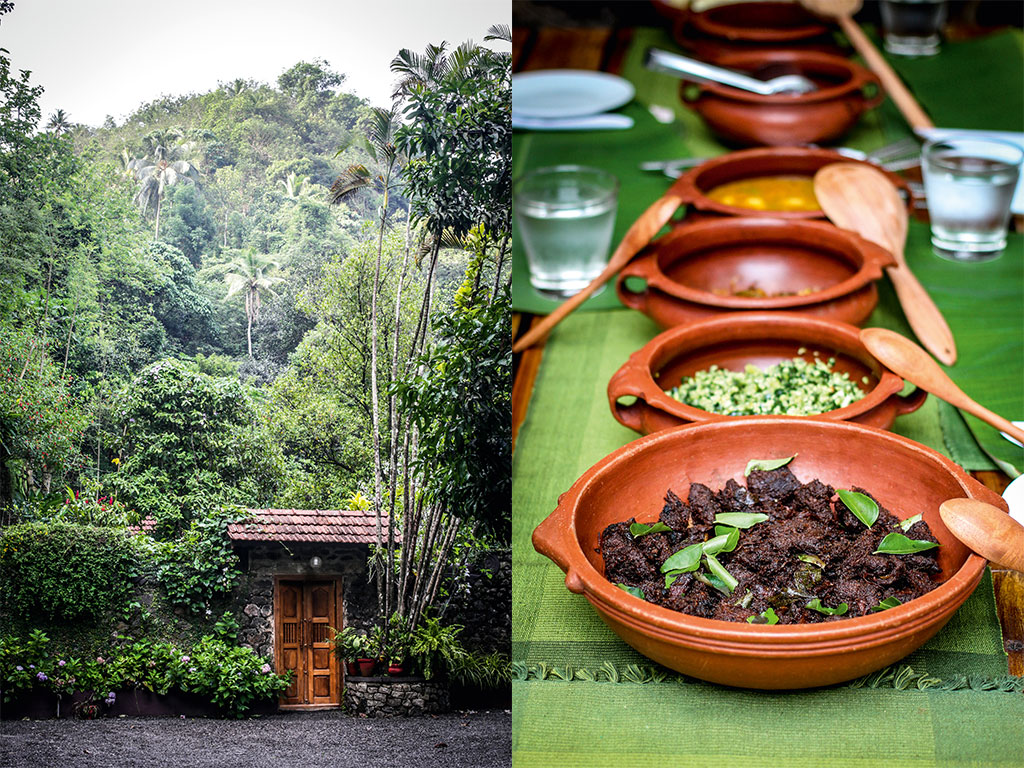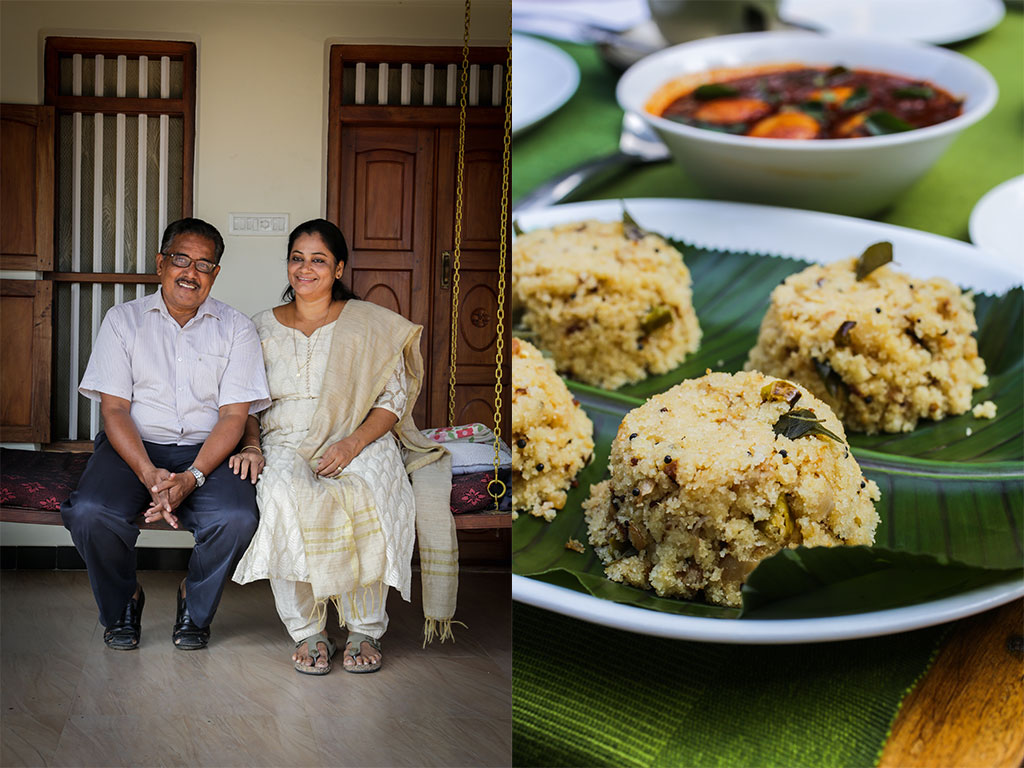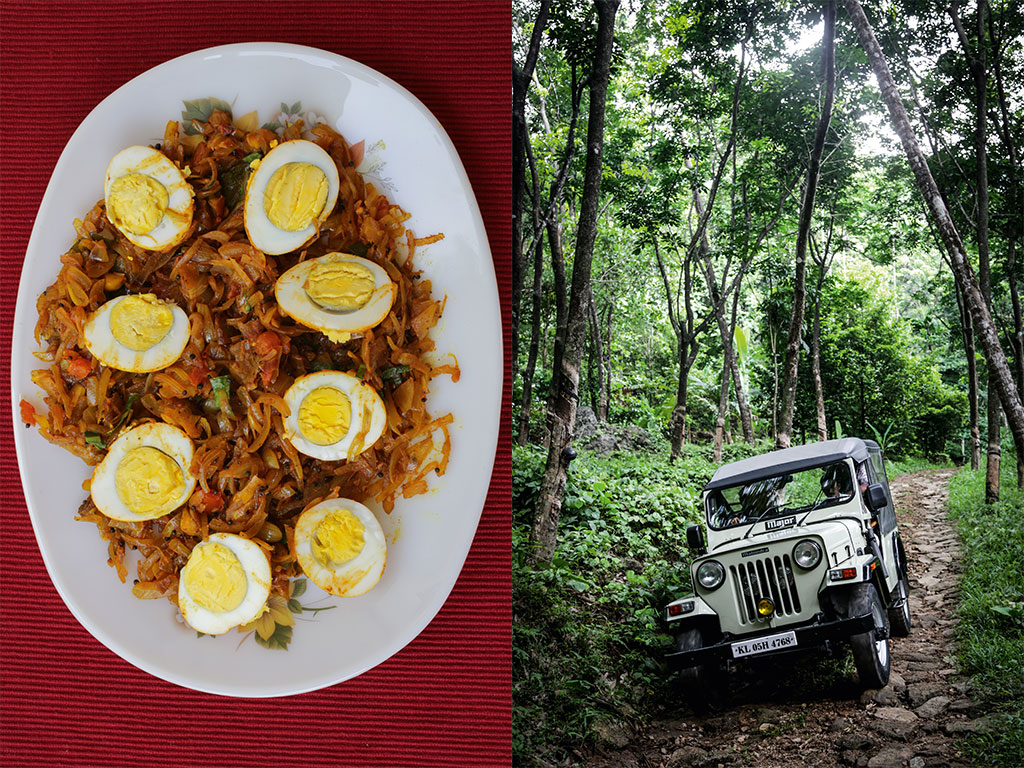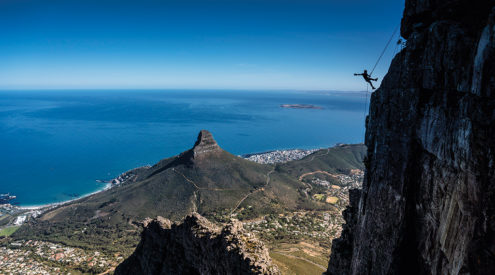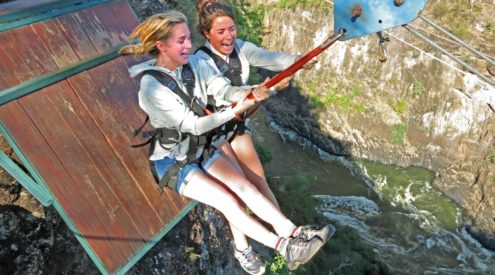The best way to get a real taste of a country is to stay with the locals. Our food editor did just that in the south of India at Kerala, where spices and heritage homestays abound.
Also read: a luxury train ride across India: Deccan decadence
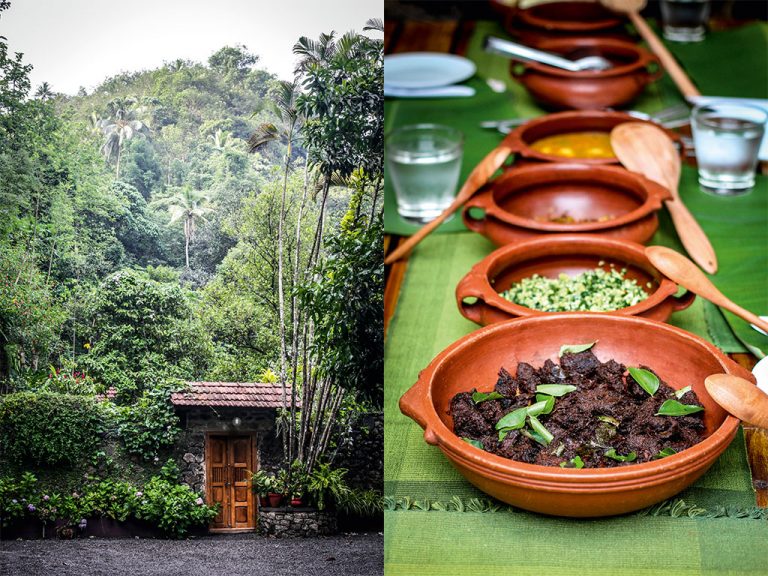
At Vanilla County, we’d wait with great anticipation to be invited into the courtyard behind the wooden door to feast off banana-leaf plates. Eating is with the right hand (although cutlery is provided); lunch at Vanilla County – the ‘beef fry’ is in front. Photo by Brandon de Kock
When quizzed about memorable food moments in Kerala, a state on India’s tropical southwestern coast, my instinctive response is pepper-banana chips with Babu. Babu Vattathara was our driver who, in the face of oncoming tuk-tuks, dictated personal recipes or tutored us in the Malayalam pronunciation of kozhy curry. He was our fixer for beer, the man with the selfie stick to hand and, after 10 days together, our friend.
It was a vague mention of snacks that prompted his detour through Alleppey to Malabar Chips, where fresh bananas are fed through an electric slicer into a gigantic wok of boiling oil. They are left to swirl and bubble, tossed in the air and then whipped out, dusted with black pepper and offered around while still warm. We couldn’t get enough of them. Perhaps it was surprise and delight in the unexpected that enhanced their flavour. What’s for certain is these ‘crisps’ underscored the unselfconscious but undeniably nutritious local diet I was about to discover at a lineup of homestays.
The first was in the backwaters of Kerala, a series of interconnected waterways where fresh water meets salt water from the Arabian Sea. Babu came to the end of a road and turned off the ignition. At a jetty a long-tail boat sporting white-painted cane chairs awaited. Steering the motor was Jomon Manichan, who didn’t say much but communicated by waggling his head from side to side with an occasional smile.
Reluctantly we waved goodbye to Babu and puttered into the unknown until the watery ‘streets’ narrowed and the tropical vegetation closed in overhead. We passed women wearing house dresses standing knee-deep in water on steps leading up to their homes. They slapped washing on a stone – one woman cradled a gold iPhone7 to her ear as she did so. Others washed out the ubiquitous cheenachetty, a thick- bottomed wok that speaks of the Chinese influence here. Children splashed and giggled as they doggy-paddled around this domestic activity. People waved as we passed. The odd plastic bottle floated by.
Also read: Photoblog: a glimpse of India

Salimma and husband Chackochan Edayady on the stoep of his ancestral home, Nelpura; uppumavu is a breakfast staple of semolina flecked with chilli, ginger, mustard seed, curry leaf and cashew nut. Photo by Brandon de Kock
When we moored in front of Nelpura, our host Salimma was waiting. She led us over her stoep, which gleamed so bright I regretted having to step on it – even with bare feet, as is the custom – and welcomed us with a lunch that became a familiar hallmark of our homestays.
Anchoring the plate was unpolished Kerala rice, shorter and fatter than basmati, covered with dal. Arranged around it were always: a crispy component, like fried bitter gourd; a dry dish called thoran, tumbled with freshly grated coconut; a saucy vegetable sambar; a fried fish cutlet rubbed with ginger, garlic, lemon juice and stained red with chilli powder; poppadoms and chapatti, a South Indian flatbread.
I still miss these lunch plates of varied vegetarian offerings and the substantial curry breakfasts of egg ‘roast’ or slow-cooked brown chickpeas. Kerala is one of the few states where eating beef is legal but it’s by no means the starting point for a meal. Rather, rice, coconut and bananas form the foundation and everything is prepared fresh and from scratch.
Most of what Salimma served during our stay came from her garden: the papaya, luscious mangoes and baby bananas at breakfast, and even her cooking oil is pressed from homegrown coconuts. Their last slaughter-sized duck of the season had been held back for our arrival so we could taste the coconut milk-based curry thengapal chertha tharavu, which is usually reserved for special occasions.
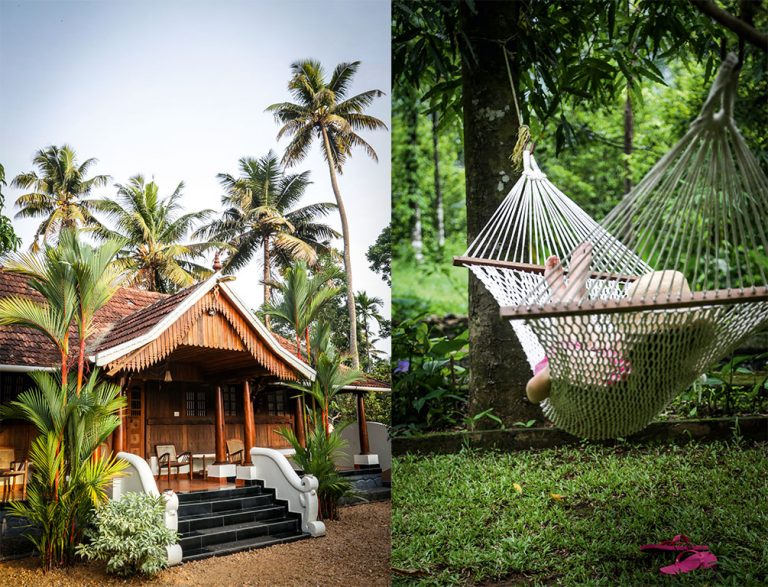
Nelpura’s guest quarters, a typical wooden home in the traditional Kerala style, set among orchids, adeniums, coconut palms and a mango tree; there were plenty of hammocks at Vanilla County and daybeds at Nelpura for relaxing and reading and taking in the tropical surroundings. Photo by Brandon de Kock
Before dinner, we headed out for a cruise with Jomon. On emerging from the narrow canals into larger bodies of water, we mingled with waterbuses and houseboats, their woven- palm coverings shaped like an armadillo’s armour shell. We watched the setting sun to the distant strains of a bamboo flute; it glowed fluorescent orange without radiating rays, like a bindi pasted onto a hazy sky.
Later we watched Salimma cook while her husband, Chackochan, sang her praises, helped out and occasionally slipped his arm around her waist. We pleaded with them to join us at the table so we could keep chatting, and they obliged. In Kerala a good host serves rather than sits with guests, and it can be unnerving having the host hovering in your blind spot, watching you eat. Usually alcohol is BYO but here two Kingfisher beers were chilling in our fridge on arrival.
From the backwaters we headed for the rich biodiversity of the Western Ghats, to Vanilla County, owned by Mathew Vallipkappen and his wife Rani. Dusk fell as we followed winding single-lane roads through scrappy-looking towns and past hillside tea plantations where shade trees reached heavenward, until a brightly lit homestead emerged from the darkness. We were shown to our rooms, spotlessly white through to the linen, by Mathew’s right-hand man, Maju Balan, who became our resident guide. We piled into a Mahindra jeep with him to visit a nearby rock pool and toured Rani’s spice garden, where he pointed out giant passion fruit, cashew fruit and one remaining vanilla creeper.
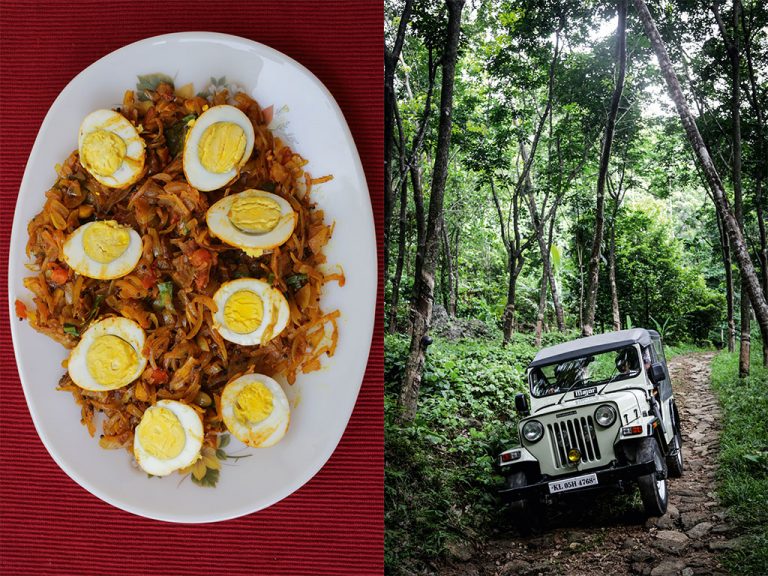
Curry for breakfast: egg ‘roast’ with spiced, sauteed onions; the Keralan landscape ranges from palm-fringed coasts to paddy fields to green hills and forest – we explored the jungle-like surrounds with Vanilla County’s Maju Balan.Photo by Brandon de Kock
At dawn we awoke to the exotic surround-sound, layered with the occasional bus tooting a musical horn as it passed somewhere high above and the ting-a-ling of the garden gate bell, all of it heightened by virtue of being so unfamiliar. The regular 06:00 solo I assumed must be Mathew, whistling as he walked to mass, but a beaming Maju informed me it’s the call of the malabar whistling thrush or, as they call it, ‘the naughty schoolboy’.
Besides that sound, one of my fondest memories of Vanilla County is a simple one: sitting on the red oxide stoep at tea time, sipping hot masala chai, snacking on jackfruit petals and battered fried bananas as sheets of rain fell and thunder broke overhead. Maju, Mathew and Rani wouldn’t blink at this scene because of its normalcy, but for me it felt so foreign and simultaneously so comforting because in that moment I was part of their family.
Rani shared her homemade banana jam, fudgy jackfruit preserves and coffee from their plantation, and at lunch a line of clay pots ran down the centre of the table; these are now used for serving alone since being replaced in every home we visited by the pressure cooker.
That said, much of the cooking is brisk, perfumed with curry leaves and popping mustard seeds. Except for a fairly recent fascination with masala dosa, the fermented rice crêpe filled with spiced potatoes eaten for breakfast, Kerala cuisine is seldom exported. Many of the ingredients I’d never seen before, like snake gourd and African coriander, which may explain why. Even the lemons look more like limes and the red onions separate out into cloves like garlic.
Having visited a tiny area of this sprawling and diverse country, I will never again use the hopelessly inadequate term ‘Indian food’. But it’s the good grace we encountered that stayed with me; clichéd as it may sound, I went for the food and fell in love with the people.
How we did India:
For us, any exploration of India has always landed on the back-burner in favour of ‘easier’ destinations – until a casual conversation with Pippa de Bruyn, who spent a decade researching India for the Frommer’s guide and now curates outbound trips through her company, Best Kept. Aside from crafting itineraries matched to interests and budget, Pippa also works with local experts who arrange transfers, guides, drivers and assistance in the case of illness or lost luggage.
Another contact, Nic Dawes, who lived in Delhi for three years, emailed on the subject of Indian cuisine: ‘If I had to pick an absolute favourite, it would probably be Kerala food.’ Pippa concurred. So the state of Kerala it was, and she focused on a central thread of heritage homestays, where all meals are catered. We enjoyed Nelpura and Vanilla County best for the quality of food, and our rooms were in a separate annex which allowed for increased privacy.
Having a driver and knowing we’d be met by a Best Kept representative at key points to ensure smooth transfers felt like true luxury. It meant we could maximise our time away rather than managing logistics in a place for which we had no reference point. We were also issued a local phone loaded with all the relevant numbers on arrival, and our hosts and guides all spoke English. Every itinerary is bespoke, but as an example: an eight-night Kerala trip for a family of four (with driver, guide, most meals and accommodation at four homestays) costs from R12725 per person. bestkept.co.za

Kerala is famous for its ornate houseboats but all kinds of vessels chug up and down the backwaters; the main house at Vanilla County plantation. Photo by Brandon de Kock
Plan your trip to southern India
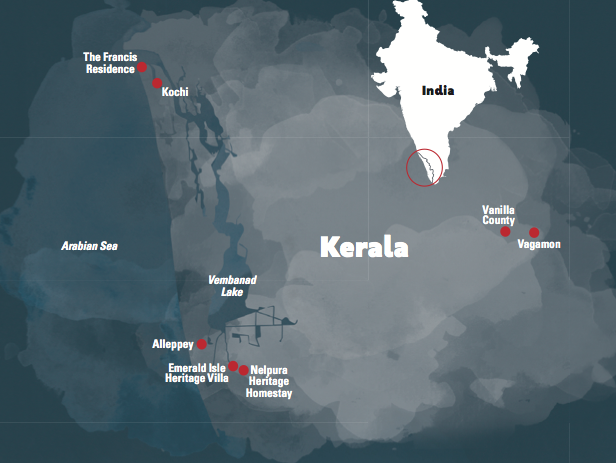
Getting there
We flew from Cape Town to Mumbai. Ethiopian Airlines flights start at R6500 return (ethiopianairlines.com) and Emirates from R7500 (emirates. com). From Mumbai we flew to Kochi with Jet Airways for R2700 (jetairways.com), then travelled by car (and boat on the backwaters). We had a designated driver, which is highly recommended.
When to go
The best time for travelling in the south is November: it’s cooler and the post-monsoon landscape is lush. We travelled in April and May when the heat and humidity peak.
Need to know
An e-visa application is completed before departure and the free visa issued on arrival in India. The exchange rate is favourable for South Africans – about 5 rupees to a rand. There are strict controls on purchasing alcohol so ask a local to help.
Stay here
Nelpura Heritage Homestay in Alleppey has a 140-year-old, traditional Keralan-style wooden structure in the garden, where guests stay. From R1425 for a double room, full board. nelpura.com
Vanilla County in Vagamon is a heritage family home that reflects the hill-plantation life. Double room from R1300, plus R90 per person for breakfast, R163 per person for lunch or dinner. vanillacounty.in
Emerald Isle Heritage Villa, a 150-year-old property in Alleppey run by brothers Vinod and Vijo Job, has more of a guesthouse feel. Double room from R1160 B&B, lunch or dinner R80 per person. emeraldislekerala.com
The Francis Residence is a homestay at Fort Kochi with warm hosts Francis and Rosy KP. It is meticulously kept and rooms are within the family home; we visited but didn’t stay here. Double room from R1080 B&B, lunch or dinner from R305 per person. francisresidence.com
Do this
Homestays have guidebooks on what to do in the area, and their own insider info. Nelpura also offered bicycles and a birdwatcher’s kit. Explore nearby villages and stop for tea and snacks.
Go for a boat ride on the backwaters.
Do a cooking class with your host.
Eat here
You will be well fed at the homestays. Know that hosts often lower spice levels for the tourist palate – we asked them to cook for us as if we were Keralan. To experience the full spectrum of local food and avoid repetition, chat to hosts about their specialities.
This taste adventure first appeared in the October issue of Getaway magazine.
The best guide to weekending in Golden Gate; how to go shark diving (without a cage); exploring the high peaks of the Rwenzoris and heritage homestays with delicious food in Kerala.










